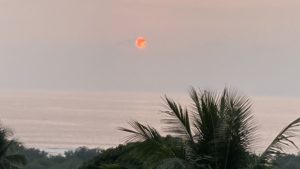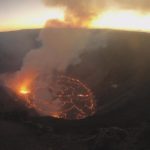Hawaiian Volcano Observatory published Thurs., Dec. 24, 2020, at 8:30 a.m.:
Activity Summary: No significant change. Lava activity is confined to Halemaʻumaʻu from two vents on the north and northwest sides of the crater. As of 7 this morning, the growing crater lake was 169 m (554 ft) deep. High SO2 emissions continued.
Summit Observations: Summit tiltmeters continued to record steady deflationary tilt. Sulfur dioxide emission rates remain high estimated at around 35,000-40,000 tonnes/day as measured on Monday (Dec. 21) and revised yesterday (Dec. 23). Seismicity remained elevated but stable, with a few minor earthquakes and tremor fluctuations related to the vigor of fissure fountaining.
Halemaʻumaʻu lava lake observations: Two vents continued erupting on the north and northwest walls of Halemaʻumaʻu. The west vent, which is located on the lowest down-dropped block within Halemaʻumaʻu crater, was intermittently active. The north vent remains the most vigorous.
The vents continued to feed lava into a rapidly enlarging lava lake filling Halemaʻumaʻu crater. As of 7 am this morning, the lake was 169 m (554 ft) deep–an increase of 12 m (39 ft) over the previous 24 hrs. From an overflight yesterday morning (Dec. 23), the approximate surface area was 25 ha (69 acres) and the lake shape was still roughly oval with an east-west length of 715 m (780 yds) and a north-south width of 460 m (500 yds).
An island of cooler, solidified lava within the lava lake has been getting smaller and drifting eastward in the lake. It appears to be about 150 m in diameter and has slowed its eastward movement as it approached the north vent this morning.
Webcam views of the lava lake can be found here: https://volcanoes.usgs.gov/volcanoes/kilauea/multimedia_webcams.html.
Hazard Analysis: High levels of volcanic gas, rockfalls, explosions, and volcanic glass particles are the primary hazards of concern regarding this new activity at Kīlauea’s summit. Large amounts of volcanic gas—primarily water vapor (H2O), carbon dioxide (CO2), and sulfur dioxide (SO2)—are continuously released during eruptions of Kīlauea Volcano. As SO2 is released from the summit during this new eruption, it will react in the atmosphere with oxygen, sunlight, moisture, and other gases and particles, and within hours to days, convert to fine particles. The particles scatter sunlight and cause the visible haze that has been observed downwind of Kīlauea, known as vog (volcanic smog), during previous summit eruptions. Vog creates the potential for airborne health hazards to residents and visitors, damages agricultural crops and other plants, and affects livestock operations. Rockfalls and minor explosions, such as the ones that occurred during the 2008–2018 lava lake eruption at Kīlauea summit, may occur suddenly and without warning. This underscores the extremely hazardous nature of Kīlauea caldera rim surrounding Halemaʻumaʻu crater, an area that has been closed to the public since late 2007. Pele’s hair and other lightweight volcanic glass fragments from the lava fountains within Halemaʻumaʻu will fall downwind of the fissure vents and lava lake, dusting the ground within a few hundred meters (yards) of the vent. High winds may waft lighter particles to greater distances. Residents are urged to minimize exposure to these volcanic particles, which can cause skin and eye irritation similar to volcanic ash.
Vog information can be found at https://vog.ivhhn.org/
Lava photo courtesy USGS/Hawaiian Volcano Observatory, taken Dec. 24, 2020, just before 6:30 a.m.
Photo below of a sun barely visible through the vog taken Tues., Dec. 22, 2020, just before sunset, near the Lutheran Church at the foot of Lako Street in Kailua-Kona

